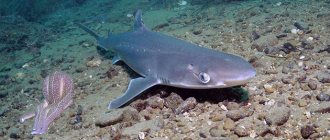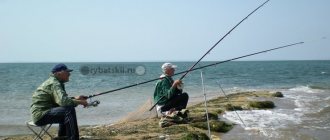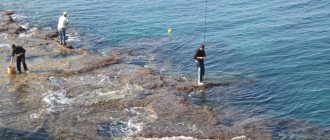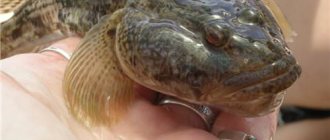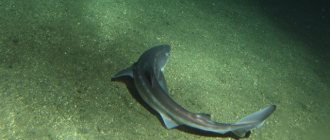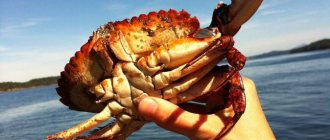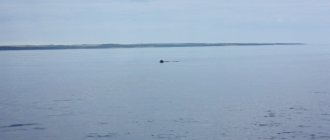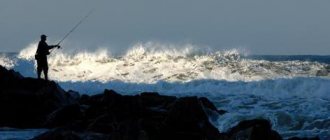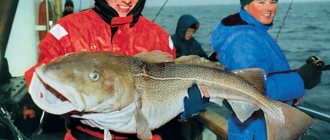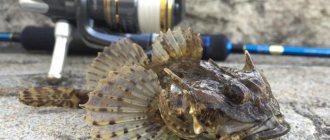Due to the many fishing vessels, cruise ships, dense surroundings by different countries, low salinity and relatively cold waters compared to the Red Sea, and most importantly, almost complete isolation from ocean waters, the Black Sea depths are not interesting for large sharks. But, of course, there are certain types of sharks in the Black Sea.
More details about these types:
Katran
The most common shark species in Black Sea waters. The length of the katran is up to a meter and a little more; individuals up to two meters are rare. The body is long, strewn with spines, which have a structure similar to teeth, i.e. The spine contains dentin, pulp, and a coating on the outside like tooth enamel. The snout is slightly reminiscent of a dog's, which is why the katran is sometimes called a sea dog. The mouth contains many sharp and small teeth in rows. The fish weighs from eight to twelve kilograms.
Katrans prefer to live in schools at a depth of up to one hundred and twenty meters; they feed on anchovy, gobies, sprat, horse mackerel and other fish. Sometimes, mainly female Katrans, can hunt dolphins.
The female's pregnancy lasts almost eighteen months, then about fifteen fry are born, up to thirty centimeters in size. Compared to their other relatives, Black Sea katrans do not live long, up to twenty years.
Balyk is made from the meat of the Black Sea shark, and the liver contains a large amount of vitamins, fats, and other substances that have a therapeutic effect on certain diseases.
Katrans never attack people, although you can get hurt on their sharp thorns, so you shouldn’t get close to them. Also, a fish can bite a fisherman whose net it is entangled in.
cat shark
The head of this fish resembles that of a cat, hence its name. This shark is also called scyllium. Their length is no more than one meter, weight up to one and a half kilograms. The streamlined, elongated body allows it to move rapidly in the depths of the sea in pursuit of prey. There are many small teeth in the mouth, which, like a brush, are capable of grinding any food.
The cat shark's diet consists of squid, shellfish, crabs, small fish, and octopus. Feeling impulses emanating from potential food, they hunt freely in the dark. They themselves also often become prey to larger marine inhabitants.
The scyllium reproduces, laying up to twenty eggs at the bottom of the clutch.
For humans, the cat shark is absolutely safe; moreover, it itself is afraid of people and hides.
sea fox
Other names: spiny or spiny stingray. It has a diamond-shaped body with a short head, two fins like wings on the sides. The top of the body is covered with spines. The teeth are very sharp, so fishermen, having caught a stingray, first stun it with a blow to the head to avoid a very traumatic bite. The body length of the stingray is up to seventy centimeters, females are larger, reaching up to one hundred and twenty centimeters. This fish got its name sea fox because of its ability to camouflage and hide on the seabed. The habitat ranges from two to forty meters.
The diet consists of crabs and small fish. The process of reproduction occurs by laying eggs. The female can lay about a hundred eggs in a few weeks.
An interesting fact from the life of a stingray is the complete change of skin at a young age. Sometimes tourists come across black scraps of clothing washed up on the shore.
Angelfish
Another of the sharks in the Black Sea, which looks like a stingray. It also has the name squatina. Angel, the shark is named for its large side fins that resemble developing wings. The skin is covered with prickly spines, and the mouth has sharp teeth. Females are larger than males, some individuals reach almost two and a half meters in length.
Squatina prefers a nocturnal lifestyle. It feeds on fish, crabs, algae, and even sometimes seabirds.
The angelfish is considered an ovoviviparous shark; the offspring can be up to twenty-five pups.
This shark is not dangerous for humans, but it can cause serious injuries to fishermen when caught, so you should be extremely careful when catching squatfish.
The meat of the sharks listed above has incredible taste and beneficial properties. The famous sea soup is prepared from the fins of the katran; grill steaks; Shark meat is also used in salads; for cold and hot snacks, as well as baked goods. The best balyks are made from shark meat. One hundred grams of shark meat contain no carbohydrates, only nine grams of fat, twenty grams of protein, and only spinal cartilage from the bones. Essentially, it is a tender, juicy, white fish fillet with a pinkish tint.
To see and try Black Sea sharks, you can go on paid fishing trips, which are organized at almost all resorts on the Black Sea coast. Having gone out on a boat into the open sea, tourists can catch a katran on their own, and the cook on the ship will immediately prepare an excellent lunch from it. The same Katrans are sold at fish markets; a carcass costs from four hundred and fifty rubles per kilogram. The price will be higher in the supermarket. If you don’t want to cook yourself, order a dish of shark meat at a fish restaurant, of which there are many along the coast.
You can simply watch sharks and even take their photos in the aquariums of resort cities.
And finally, I would like to note that sometimes large sharks get into the Black Sea, although for these individuals it is very difficult. This is a white shark that lives in the Mediterranean Sea. Since after climate change, the waters of the Black Sea have become warmer than before, the white guest can swim into the Black Sea territory, but not for long. Also, there is one known case of fishermen catching a goblin shark, a resident of the Pacific Ocean. Only the katran and cat shark live permanently in the Black Sea. There have been no cases of shark attacks on humans on the Black Sea coast, but this does not mean that you need to neglect your own safety measures. The depths of the sea hold many unsolved secrets.
Scary inhabitants of the deep sea...
There are more than 450 species of “terrible” predators in the world. The smallest shark is the deep-dweller Etmopterus perryi. Her body length is only 17 centimeters. The largest is the whale shark with a body length of about 20 meters, which is also the largest fish on the planet.
“Wow the size! I wouldn’t want to meet her on the Black Sea!” - tourists will think and they will be wrong: giant sharks - whale and giant - are completely harmless to humans. They feed on plankton and small crustaceans, filtering sea water like whales. But representatives of smaller species - nurse sharks and leopard sharks - sometimes show unexpected aggressiveness and attack swimmers.
The list of dangerous shark species today consists of fifty species, and among them there are those that pose a threat to human life. The leaders of this “red” rating are:
- bull shark (aggressive, has long been known for attacks on people; man-eater);
- white shark (the legendary man-eating shark, also the main character of the film “Jaws”);
- tiger shark (one of the most common species on Earth; man-eater);
- long-winged shark (a most dangerous species; a man-eater that has caused the death of thousands of people stranded in the water due to shipwrecks or plane crashes);
- mako shark (often attacks people, killing or maiming them);
- gray reef shark (cases of attacks on divers have been recorded);
- sand shark (single attacks on people);
- hammerhead shark (despite its ominous appearance, humans are rarely attacked);
- blue shark (as of 2011, 34 attacks on humans were recorded, of which 8 attacks resulted in the death of the victim);
- lemon shark (no cases of attacks with “consequences” have been recorded; considered potentially dangerous to humans).
The only way sharks can get from the World Ocean to the Black Sea is from the Mediterranean Sea through the Bosphorus Strait. In Mediterranean waters there are about 47 species of dangerous predators, of which in 16 species some individuals reach 3 meters in length. 15 species of Mediterranean sharks are considered potentially dangerous to humans. Checking the lists, we discover the already familiar “man-eaters”: white and bull sharks.
Black Sea sharks
Local residents of the Black Sea coast and especially avid fishermen know that there are still sharks in the Black Sea. Scientifically, such a fish is called the Black Sea Katran. This fish reaches a length of 1.5 - 1.8 meters and can weigh up to 15 kilograms. Some call the katran a sea dog because of the similarity of the fish's head to the skull of a dog.
How to make 2 from 1 ziplock bag: a woman showed a trick with scissors and a knife
To make tomato seeds germinate faster, I soak them in a special solution.
A pregnant woman burst into tears after receiving a wedding invitation. The bride made a condition
Also in the waters of the Black Sea you can find the small-spotted catshark. However, the waters of the Mediterranean Sea are still recognized as its natural habitat. But fish sometimes swim through the Bosphorus Strait. She is not big. Length - less than a meter and weight, like a cat. Only 1.5 - 2 kilograms.
Interesting facts about Katrans living in the Black Sea waters
Of course, the Black Sea is filled with the most unusual inhabitants. For example, the Katran shark, known to scientists, has a length of approximately 2 m. However, the most common are individuals with a length of 1.5 m. They are practically harmless. Some exotic lovers even keep Katrana in home aquariums.
This species is quite widespread. However, it should be remembered that this fish is cold-loving and does not like warm waters too much.
It very rarely rises to the surface of the water and does not approach the picturesque Black Sea coast at all. Katrans live at quite great depths, constantly gathering in schools. They most often feed on invertebrates and bottom-dwelling fish such as anchovy, flounder and whiting.
Katran is an ovoviviparous fish species. Her pregnancy lasts for about 2 years. Very active baby sharks are born 100% ready for a life full of dangers. Almost inaccessible to people, very careful and protected by the depths of the sea, they successfully grow there and continue to exist.
Katran is completely safe for people who want to know if there are sharks in the Black Sea.
He does not swim close to vacationers who are enjoying swimming. The fact is that a unique olfactory system helps this nimble fish avoid undesirable encounters with humans.
What sharks live in the Black Sea?
The Black Sea is an almost completely isolated body of water. From the open ocean you can only get here through several straits, which makes this inaccessible place not very attractive for large representatives of ocean life.
In addition, large species of sharks “will not appreciate” the living conditions that the Black Sea offers - many densely populated areas on the shores, fishing activity, cargo transportation, cruise and pleasure boats. Overall, this sea is too active for large sharks.
However, we should not forget the smaller brothers of this large family. Thus, in different areas of the Black Sea, two types of sharks are found at once - the cat shark and the spiny shark, more often called the katran.
Common shark of the Black Sea - katran
The Black Sea katran, or spotted spiny shark, is a small fish, most of which does not reach one and a half meters in length. However, some individual specimens can grow up to two meters, and sometimes exceed this figure.
However, you shouldn’t worry about even the largest katrans - it’s a waste of time.
Spotted spiny sharks feed on the fish that spread along the Black Sea coast. True, they do not limit themselves to this at all. Their main food, depending on the season, is such types of fish as anchovy, horse mackerel, sprat and whiting.
However, any other fish they meet along the way can become a pleasant addition to the diet. It should also be mentioned that adult Katrans, and especially large females, can hunt small dolphins.
The katran cannot boast of a long life, during which it can reach frightening sizes. Most often, these fish do not live even two decades.
Katran is a fish easily recognized by fishermen. The steel-gray back, sometimes with dark brown splashes, smoothly flows into light sides and a completely white belly. The appearance seems to have been copied, with some exaggeration, from the big brothers, large sharks.
However, the elongated body and mouth filled with small and quite sharp teeth fade into the background when people notice the pointed rostrum. Thanks to him, the face of the Black Sea shark takes on an almost dog-like expression.
Another distinctive feature of the katran is the skin of its back, studded with small but very sharp spines . They are especially densely located around the fin. Any fisherman who has caught a spotted shark is familiar with the dangerous business of grabbing a fish.
The thorns can go quite deep into the body, but this is not the danger - they are very easy to remove, since they are shaped like teeth and are quickly pulled out. The problem is that they are coated with poison, which can cause several unpleasant hours, or even days, for the unlucky and overconfident grabber.
Katrans lead a gregarious lifestyle, living in fairly large groups near the seabed. In summer, flocks rise much higher than in winter - only forty meters from the surface versus one hundred and fifty.
Groups of spotted spiny sharks come closest to the surface when it is time to give birth - at these moments, approximately in mid-autumn, off the coast, the katrans rise to a depth of twenty to thirty meters.
However, all of the above does not in any way reduce the chances of seeing a Black Sea shark right on the surface of the water.
The cat shark is another predator of the Black Sea
The cat shark is the second most common shark species in the Black Sea. This water area is not its usual habitat, unlike the same katran. However, quite a lot of these fish enter the sea through the Bosphorus Strait from the Atlantic Ocean, which serves as their home.
Cat sharks look even less impressive than spotted spiny sharks. The length of the average specimen is on average seventy centimeters. Those that have grown up to a meter are considered very large specimens, and fish that have exceeded this limit are almost unique.
You can meet a cat shark on the coast , but with the same success you can search in the bottom areas, quite distant from the coast. In these places the predator finds its prey. All of it is almost motionless, or weakly mobile. It includes both annelids and various mollusks.
These sharks often eat crabs, but actively hunting fish is not their habit. Such hunting may occur, but it is the exception rather than commonplace.
The lifespan of cat sharks is much less than that of the katran, and is only a dozen years. The appearance is not particularly graceful - a thin, long body of light brown color, smoothly flowing into a white belly. The back, sides and fins are often covered with black or dark spots.
The mouth folds into the usual crescent shape for sharks, but cat sharks are unable to inflict any serious wounds with their small teeth. At least this is true for humans.
Why are there no big sharks in the Black Sea?
Sharks that enter the Black Sea through the Bosphorus will not live long due to unfavorable living conditions, because... the Black Sea waters have too little salt content. Closer to the surface, this figure is only 17%. Due to such conditions, predators do not sail far from the Bosphorus.
Mediterranean sharks cannot breed in Black Sea waters. This is also due to low salt levels. The eggs, not having time to ripen, die. Therefore, the white shark will not survive in the Black Sea. Large sharks are quite voracious. They are constantly moving, in search of food. However, the Black Sea fauna is not able to satisfy the appetites of large predators.
Another reason why there are no sharks in the Black Sea is the climate. Conditions in this region are quite mild, but in winter the water can cool down to +9 degrees Celsius. Large sharks could not survive such cold weather.
Predators of the Black Sea
Despite the fact that sharks in the Black Sea are absolutely harmless, you should still beware of some representatives of the local fauna. For example, it is better to be careful around jellyfish. Contact with them, although not fatal, leaves behind painful burns.
What is found in the Black Sea besides jellyfish? Caution must be exercised in relation to the spines of sea ruffes and the fin of the sea dragon, which is covered with poison. Pinching a crab can cause some discomfort. You should also stay away from the cat ray and fox ray, as they can inflict deep wounds on swimmers with their long tails.
Sharks of the Black Sea
Many people know that the Black Sea is one of the safest in the world. There are few poisonous fish here, no sea urchins, no sea snakes, no sharp corals, and even of the two jellyfish that live, only one stings - and that only causes redness of the skin. And only one species of shark lives here, and it’s only a meter in size. Is there only one type?
The Black Sea is practically closed. It has only two small straits connecting with other seas: on the one hand, the Kerch Strait with the Sea of Azov, on the other, through the Bosphorus, with the Marmara and Aegean Seas, and then the Mediterranean and the Atlantic Ocean. And if you can’t expect live surprises from the Sea of Azov, then through the Bosphorus Gate a lot of interesting things enter the Black Sea, including sharks. Many different sharks!
Black Sea Katran (Squalus acanthias ponticus)
Black Sea Katran (Squalus acanthias ponticus). Photo fishbiosystem.ru
This is the “only” shark of the Black Sea. More precisely, it is the only permanently living one. The Black Sea subspecies is one of the most common shark species in the world. Here they reach their largest sizes, up to about 2 meters, but are not dangerous to humans. The basis of the diet is fish, and quite small ones: anchovy, sprat, red mullet, sardine, herring and others.
The main threat to the population is overfishing. This is due to the extremely low rate of reproduction, late sexual maturity (occurs at the age of 13–17 years) and the long period of development of eggs and embryos in the female’s body (about 18 months). Previously, the katran was more numerous, but now there are quite a lot of them, and the predator is not listed in the Red Data Books of the countries of the region. Although in some countries this issue is already beginning to be raised.
Commercial shark fishing is permitted, but, for example, in Russia it is caught much less than the permitted quota.
Common catshark (Scyliorhinus canicula)
Common catshark (Scyliorhinus canicula). Photo by Copejans Evy
Another small shark (up to 1 meter), quite often found in the Black Sea. This is a bottom-dwelling species that feeds on crabs, shrimp and even worms. Like the katran, it does not pose a danger to humans, especially since it is active at night.
It is regularly recorded off the Turkish coast, less often near Bulgaria. In terms of the frequency of encounters in the Black Sea, it can safely be placed in second place. Some sites dedicated to fishing in the Black Sea talk about methods of catching cat sharks, although it was not possible to find a photo of the trophy.
Longspined spiny shark (Squalus blainville)
Longspined spiny shark (Squalus blainville). Photo fishbiosystem.ru
Another small shark and the closest relative of the katran. Like Scyliorhinus canicula, it barely reaches 1 meter in length. The range covers the Atlantic, Indian and Pacific oceans. There is a fairly large population in the Mediterranean Sea, and it is commercially fished.
It is a fairly frequent visitor to the Black Sea and swims further than others. The long-spined shark has been spotted off the coast of Turkey, Bulgaria and neighboring Georgia.
Common sea fox (Alopias vulpinus)
Common sea fox (Alopias vulpinus) Photo gooddive.com
Now this is a shark of serious size. Its length is up to 6 meters, however, about half of this size is in the tail. It is generally the most unusual and noticeable part of a fish’s body. But this is not the only thing that makes the sea fox remarkable; its body temperature is always higher than the temperature of the surrounding water. This is extremely rare in fish.
Alopias vulpinus feeds on fish, most often small pelagic fish, such as bluefish, mackerel, herring, and garfish. When hunting prey, it can develop high speed. But, fortunately, it is not dangerous to humans, although there have been several cases of injuries inflicted by a shark.
In the Black Sea it is extremely rare to find off the coast of Turkey and Bulgaria. Until the middle of the last century, the sea fox was recorded relatively often in our waters, but in recent years it has become less and less common. The last known case occurred on November 8, 1996 near the Turkish city of Sile.
Angelfish (Squatina squatina)
Angelfish (Squatina squatina). Photo by Michael Sealey
Another shark that periodically swims into the Black Sea and is nocturnal. Its beautiful name does not hide aggression. It is harmless and quite modest in size, with a maximum length of about 2 meters. Its shape immediately reveals a bottom predator, and at a quick glance it may even seem that it is a stingray.
In the Black Sea it was recorded off the coast of Turkey and Bulgaria. In recent years, there is no data on the capture of sea angel. Most likely, this is due to the fact that there is less of it in the neighboring seas - Marmara, Aegean and Mediterranean.
Hammerhead shark (Sphyrna zygaena)
Hammerhead shark (Sphyrna zygaena). Photo by Andy Murch
The only potentially dangerous shark that swims into the Black Sea. Its length is up to 5 meters. This is a fast and quite aggressive predator. The basis of the diet is fish, such as herring, perch, and stingray.
Every year, dozens of attacks by these hammerhead sharks on people are recorded all over the world, but not in the Black Sea. Although we sometimes record this shark off the coast of Romania, Bulgaria and Turkey, it has never eaten people. And due to the decline in the number of the species in neighboring seas, the likelihood of Sphyrna zygaena entering the Black Sea through the Bosporus is becoming less and less.
Subscribe to our channel in Yandex.Zen
How dangerous are Black Sea sharks for humans?
Both types of sharks do not pose any threat to humans due to their extreme caution and small size. But a frightened person can sometimes act quite stupidly, thereby creating a dangerous situation.
The most likely way to encounter a shark is while diving or spearfishing.
Katran and cat sharks will never be the first to attack a person.
Therefore, diving in the Black Sea is safer in terms of shark attacks than, for example, in the Red or Mediterranean Sea.
Episodes associated with attacks by toothy predators and resulting injuries occur in the event of provocation or accidental contact with a shark.
In this case, in defense, the shark can bite hard and show all its shark nature.
In addition, if you try to catch a katran with your hands, you can be painfully pricked by sharp poisonous spines and learn from your own experience that the shark is truly a dangerous fish.
laguna-akul.ru
cat shark
Home ❱
Flora and fauna
❱
Sharks in the Black Sea
❱
cat shark
The catshark, or scyllium, is a species of small shark that lives in the waters of the Atlantic Ocean. These are predominantly nocturnal predators of unusual color.
Sharks received this name due to the similarity in head shape to domestic cats. They are quite mobile and maneuverable. These are the most active and widespread sharks in the warm waters of the seas of tropical regions.
The meat of this species of shark is edible and is often used in exotic cooking.
Short description
There are several species of cat sharks, which share the same morphological characteristics.
The size of the fish does not exceed one meter. Weight ranges from 1 to 1.5 kilograms.
The body is long, elongated, streamlined, which allows the shark to develop high speed in pursuit of prey. The head is round, the eyes are covered with a nictitating membrane, which protects them from injury. There are 5 pairs of gill slits on the sides of the head.
The mouth is wide, with small teeth that form hard bristles that grind any food.
The coloring of different species varies significantly. The Australian coral cat shark has a mottled, distinctive coloration, while the body of the Madeira black cat shark is dark and monochromatic. All sea cats are quite small, only the leatherback and humpback catsharks can grow up to three meters in length. The fins are well developed, especially the pectoral ones. The anal and abdominal ones are slightly smaller. The tail is long with a poorly developed lower part.
Habitats
The distribution area of cat sharks is quite large. They are not found only in the Arctic Ocean - the water there is too cold. The common cat shark can be observed in the summer months in the waves of the Black Sea, where it emerges from the Mediterranean. A blackmouth shark has been spotted in the northern waters of our region. She chooses the bottom of coastal waters for living. The predator does not pose a danger to humans; its diet consists of crustaceans and small fish.
Nutrition
The food supply of cat sharks consists of medium-sized squids and octopuses, bottom invertebrates and small fish that live in bottom waters. They have acute vision and sense of smell, allowing them to easily recognize prey in the dark. Sharks sense impulses and use them to find prey.
They hunt mainly from ambushes for aquatic vegetation and stones. Active in pursuit of prey. Cat sharks, due to their small size, often become food for larger predatory fish.
Reproduction
Reproduction occurs by oviposition. Females lay up to 20 eggs, each about 5 centimeters in size. Some species are ovoviviparous - they carry their young in their body for a set period of time.
You might be interested
- Shark Katran
Shark Katran
- Are sharks dangerous in the Black Sea?
Are sharks dangerous in the Black Sea?
Noticed an error or irrelevant information? Please inform
us about this
send a message
Send Cancel
Why are there dolphins but not sharks?
If we turn to zoology, it turns out that a shark is a type of fish. The dolphin belongs to the class of mammals. Therefore, the chemical component of water is important for sharks, because they breathe with gills. To extract oxygen, the shark passes tons of water through its body. And, as you know, there is a lot of hydrogen sulfide in the Black Sea, which makes it healing for humans, but destructive for many marine predators. They simply cannot breathe in such conditions.
Dolphins, like people, breathe through their lungs. They can simply hold their breath for up to half an hour and do without oxygen at all.
Based on all of the above, we can conclude that the waters of the Black Sea are unique in composition. There are very few living creatures in them; compared to other seas, there are no predators at all. Therefore, you can safely swim, but also not forget about the environmental component, because it is so easy to destroy, but difficult to recreate.
Found a violation? Report content
